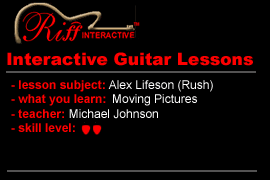Scroll through the lesson and click on notation/video/audio links to load the interactive players.
Please subscribe to get full access to all lessons for only $7.95/month PLUS 1 week free trial.

Riff Interactive lessons are
LESS expensive and
MORE interactive than alternatives!
More Info
|
|

Teacher: Welcome class to the lesson on the
style of Alex Lifeson. In this lesson we will cover their "Moving Pictures"
era. This was the period when Rush's song writing and progressive rock
style came together. Many of the songs got a lot of air play which helped
Rush reach a new level in their career. Check out the lesson sample of what you
will learn.
Lesson Sample - Lowband - 1.4 Meg
Lesson Sample - Highband - 3.8 Meg
Teacher: The first section starts off with a
harmonic pattern on the guitar that layers the bass and drum tracks. Here's the
pattern.
Part
1
Part 1
Teacher: Harmonic are easy to play if you
understand how to use the technique. You position your finger directly over the
12th fret (in this case) while barely touching the strings. Here's an example.
Harmonic Picking -
Over 12th Fret

Teacher: This next picture will show how the
finger slightly touches the string.
Harmonic Picking Technique

Teacher: In this harmonic pattern you play
between the 12th and 7th frets. Harmonics are easy to play over the 3rd, 5th,
7th, & 12th frets. Here's a jam track of part 1.
Looping Jam
Track 1 - Lowband
Teacher:
Let's move to the next section. You will play a rhythm pattern in
A.
Part 2
Part 2
Teacher:
For this rhythm pattern you anchor your 1st finger, barred in the A position on
the 2nd fret of the 2nd, 3rd and 4th strings. This allows you to switch quickly
to the various inversions of the A chord. You start with an A with a sus4 and
back, then you move to playing a C# bass note over the A, then a G note over A
and later F# over A. Notice you use the same rhythm variations while you change
only the bass notes. Here's the jam
tack.
Looping Jam
Track 2 - Lowband
Teacher:
Practice this pattern a few times and then we will move on. This section will
take a little practice, because of the chord variations. Let's move on to the
next section. This section uses a combination of power chords and a repeating
riff theme.
Part
3
Part 3
Teacher:
You continue to play using a common chord, in this case E, while the bass notes
change. Notice you play the E and B string open (1st & 2nd strings), while
you hold down the unison B note using your 4th finger on the 4th fret/3rd
string. The unison note helps to thicken up the sound of the chord. Only in
bars 3 and 4 do you play a sus2 barre chord, The rest of the phrase uses the
unison note combination. Here's the jam track.
Looping Jam
Track 3 - Lowband
Teacher:
Let's move to the next part, in this section play a riff using an ascending
scale pattern.
Part 4
Part 4
Teacher:
In this pattern you start by ascending and descending the C Major
scale.
C Major
Scale
Teacher:
Later in the phrase you shift the pattern to a relative scale to finish off the
riff. Here's the jam track.
Looping Jam Track 4 - Lowband
Teacher:
The riff sounds cool when played with the bass and drums. Here's the next part,
in this section you play a repeating riff theme in A.
Part 5
Part 5
Teacher:
Notice how the riff pattern shifts up a whole and a half-step in bar 5. Then it
shifts back to the original key. Here's the jam
track.
Looping Jam
Track 5 - Lowband
Teacher:
Now you can add a melody over these chord changes. Here's the next
part.
Part
6
Part 6
Teacher:
This is a simple melody. Notice you use a half-step bend in bars 2 and
4. You use a hammer/pull-off combination in bars 6 and 8. Here's the jam
track for this part.
Looping Jam Track 6 - Lowband
Teacher:
Now you can solo over the bass and drum track, first here's the looping jam
track you'll use to play over for the upcoming licks.
Looping Jam
Track 7 - Lowband
Teacher:
Here's the first part of the solo.
Part 7 - Solo 1
Part 7 - Solo
1
Teacher:
This solo has a cool middle eastern type sound. The scale uses the E Harmonic
Minor pattern and relative positions around the main
scale.
E Harmonic
Minor
Teacher:
Notice how the solo also uses the same scale while descending the 1st string as
well. Here's the next part of the solo.
Part 7 - Solo 2
Part 7 - Solo
2
Teacher:
This section uses the B Phrygian scale with a major 3rd note in bar 2. Bar 3
uses a cool hammer/pull-off combination that also uses the open string to add
additional notes. The extra note allows this section to sound faster. Bars 4
& 5 uses the same notes of the scale pattern, but this time descending the
1st string (E). Bars 6 & 7 again use the hammer/pull-off technique on the 3rd
string G. This section sounds like Alan Holdsworth.
Teacher: Well time to go, see you next
lesson!
|
<< load notation from left
|
|
<< load audio from left
|
<< load audio from left
|